An Inclusive Guide to Different Types of Capacitors and Their Manufacturing Processes
Capacitors are desired components in the field of modern electronics, used in everything from basic energy storage to intricate power control systems. This article explores the intricate world of capacitors, detailing their composition, manufacturing processes, and diverse applications. At the core of a capacitor lies its ability to store and release electrical energy through configurations of conductive plates separated by dielectric materials. These components are meticulously engineered to meet specific electronic requirements, such as voltage handling, temperature resistance, and capacitance values. It digs into the nuances of various capacitor types—including electrolytic, ceramic, film, and supercapacitors—and their unique properties, tailored manufacturing techniques, and serious roles in both everyday and advanced technologies are examined. This comprehensive overview not only highlights the technical sophistication behind capacitor manufacturing but also underscores their requisite role in enhancing the performance and reliability of electronic devices.
Catalog
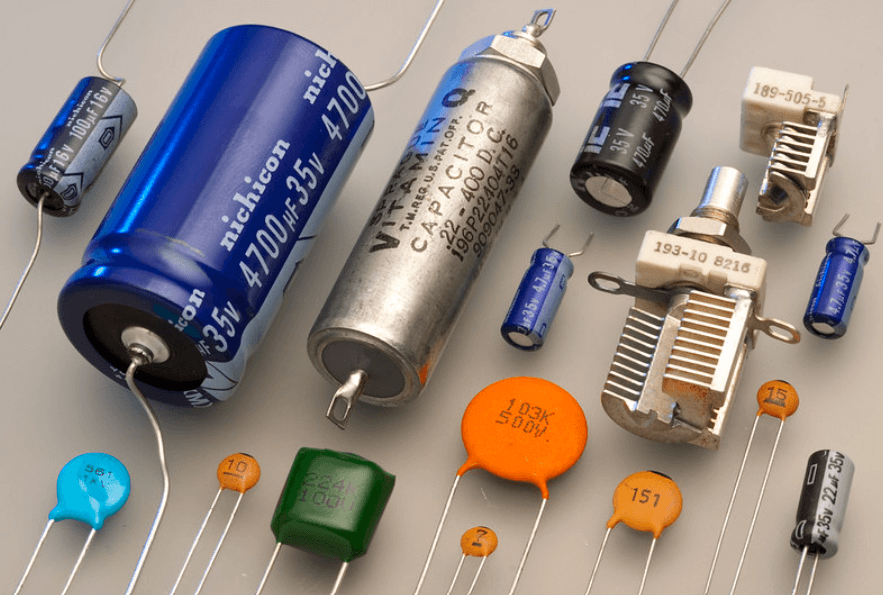
Figure 1: Capacitors
Composition of Capacitors: What Materials Are Used?
Capacitors play a powerful role in modern electronics. They consist of two conductive plates—usually made of metal—separated by a dielectric material, which is an insulator that blocks charge flow but allows energy storage in the electric field formed between the plates. The key factors determining a capacitor's ability to store electrical energy, known as capacitance, include the surface area of the plates, the distance between them, and the properties of the dielectric material.
The larger the surface area of the plates, the more charge they can hold, directly increasing the capacitance. This is because a greater area provides more space for charge accumulation. The spacing between the plates is equally authoritative. A smaller gap results in a stronger electric field, which enhances capacitance. This stronger field allows for more effective energy storage. The type of dielectric material is also dominant. Materials with higher permittivity, which measures a material's ability to store electrical energy in an electric field, enable greater charge storage at a given voltage. This boosts the capacitor’s overall effectiveness.
Two Fundamental Types of Capacitors
Capacitors are divided into two main categories: fixed and variable. Both types rely on the principles of electrostatics but are designed for different purposes based on their construction and functionality.
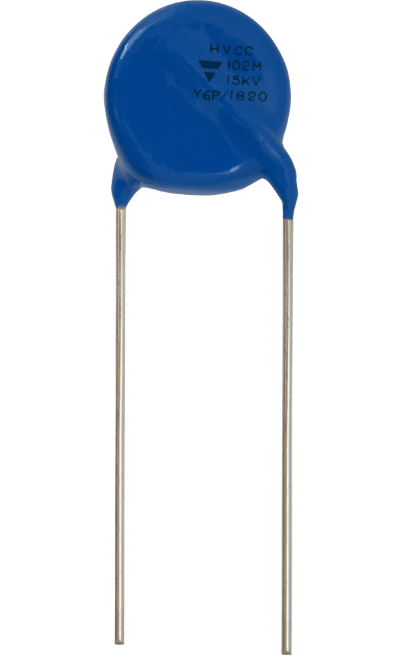
Figure 2: Fixed Capacitors
Fixed capacitors have a set capacitance value that remains constant during use. These are ideal for situations where stability and reliability are persistent, and the required capacitance is clearly defined. Common applications include filtering in electronic circuits and reducing noise. The materials used for fixed capacitors vary, with options like mica, ceramic, plastic, metal film, and electrolytic. Each material offers unique advantages, such as better temperature stability, higher voltage capacity, or longer lifespan, making them suitable for a wide range of electronic applications.
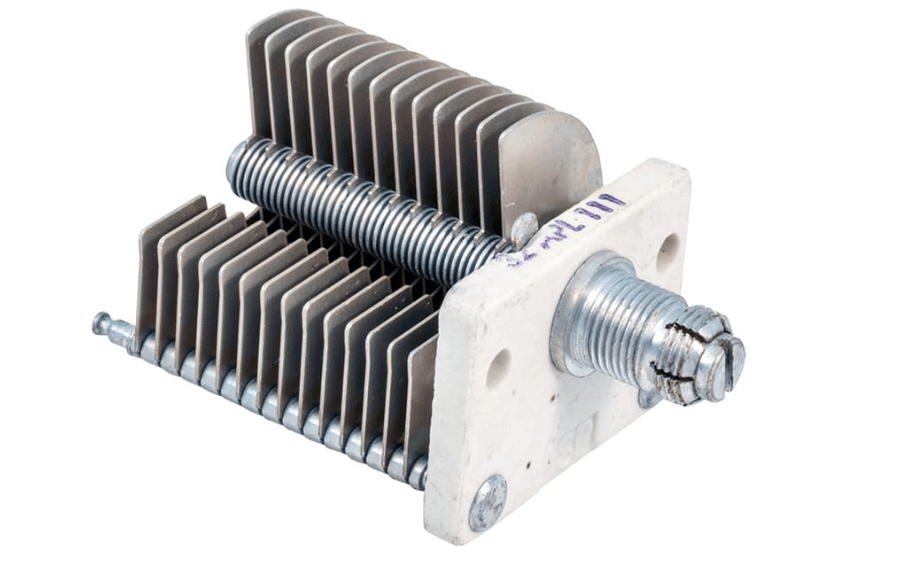
Figure 3: Variable Capacitors
Variable capacitors, in contrast, allow for capacitance adjustment. This is typically done mechanically by changing the spacing between the electrodes or altering the overlapping area of the plates. One common method involves a rotatable shaft that adjusts the position of one plate, effectively changing the capacitance. Variable capacitors are required in tuning circuits, such as those found in radio frequency (RF) receivers, where precise adjustments are needed to match specific frequencies.
Capacitor Manufacturing Variations
Capacitor production is a highly precise process that hinges on the careful selection of materials, manufacturing methods, and the specific functions they are intended to serve. This delicate balance determines the cost-effectiveness, performance, and suitability of capacitors for a variety of applications. Materials such as metals, ceramics, and synthetic films are chosen for their impact on electrical properties like capacitance, voltage rating, and temperature tolerance, which are core in meeting the specific requirements of different electronic devices.
Manufacturing techniques such as etching, layering, and sintering play a serious role in shaping the final characteristics of capacitors. These processes are meticulously managed to customize capacitors to the exact specifications desired for their intended use. For instance, enhancing the surface area of materials like aluminum in electrolytic capacitors increases their capacitance, while the use of multi-layer ceramic capacitors (MLCCs) involves alternating ceramic and metallic layers to optimize performance. Sintering solidifies the materials and enhances their electrical properties, powerful for the efficiency of both ceramic and film capacitors.
The production of capacitors also requires a high degree of customization to meet the varied demands of different sectors. Consumer electronics, for example, demand capacitors that are both cost-effective and reliable, whereas more specialized sectors like aerospace and automotive require capacitors capable of withstanding extreme conditions and delivering high performance. By strategically aligning design choices, material selection, and manufacturing precision, manufacturers can produce capacitors that not only meet but often exceed the stringent requirements of modern electronics, ensuring their effectiveness in a wide range of applications.

Figure 4: Ceramic Capacitors (MLCCS)
Production Process of Ceramic Capacitors (MLCCs)
Multi-layer ceramic Capacitors (MLCCs) are desperate components in modern electronics, known for their durability and efficiency. The manufacturing process is detailed and involves several precise steps.
The process starts with finely milled ceramic powder mixed with a binder to create a slurry. This slurry is uniformly spread onto a metal substrate. Multiple layers of this ceramic slurry are alternated with layers of metallic paste, which form the internal electrodes. Once the layers are built up, the structure is pressed to ensure cohesion. The pressed structure is then carefully cut into individual chips. These chips are the basic units that will become the capacitors. The chips are subjected to high-temperature kiln firing. This step solidifies the ceramic material and removes the organic binder. The firing process not only strengthens the ceramic but also ensures the purity and integrity of the dielectric material.
After firing, the chips undergo sintering at high temperatures. During this process, metal terminal ends are attached to the chips. This step helps enhance their conductivity and ensures they can be seamlessly integrated into electronic circuit boards. These high-temperature processes confer enhanced durability and operational reliability to the capacitors, making MLCCs requisite in a wide range of electronic devices. Through these carefully controlled steps, MLCCs are produced to meet the high standards required in modern electronics, ensuring they function reliably in various applications.
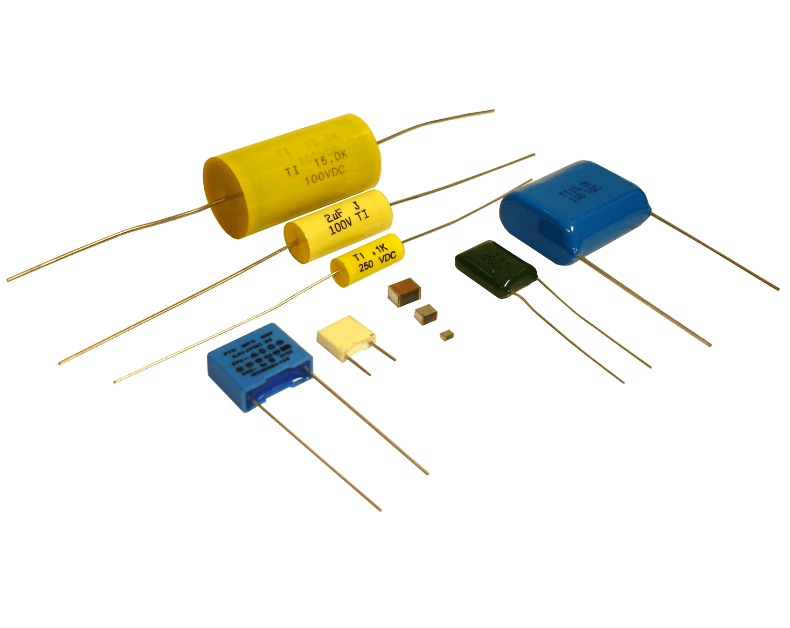
Figure 5: Film Capacitor
Manufacturing of Film Capacitors
Film capacitors are valued for their durability and high performance under extreme conditions. Their manufacturing process is detailed and precise.
The process begins with choosing a suitable plastic film for the dielectric. This film is either directly metalized or layered with thin metal sheets to form the electrodes. The selection and preparation of these materials are influential in meeting specific capacitance requirements.
The plastic films are meticulously cut and wound. This step is required to achieve the precise capacitance specifications required for different applications. Proper winding ensures the capacitor will perform reliably. Once the films and electrodes are assembled, the components are securely encapsulated. This encapsulation protects the capacitors from moisture, temperature changes, and other environmental hazards, ensuring their integrity and longevity.
The choice of film material is risky. Common options include polyester, polypropylene, and polystyrene, each offering unique dielectric properties. For example, metalized polyester film capacitors are often chosen for their high reliability and stability over long periods. Film capacitors are used in various applications due to their low inductance and robust construction. They are useful in industrial electronics and power management systems.
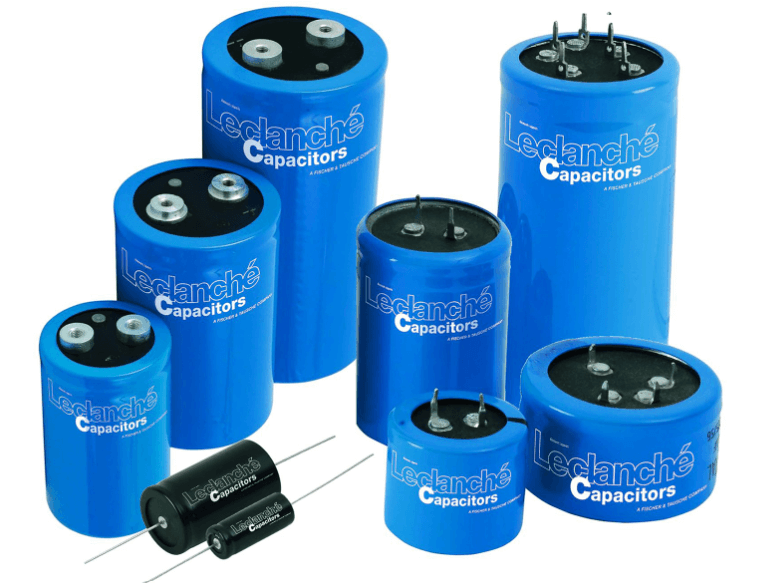
Figure 6: Electrolytic Capacitors
How Electrolytic Capacitors Are Constructed?
Electrolytic capacitors are popular in applications that need high capacitance in a compact form. They offer great cost-efficiency and significant energy storage compared to ceramic or film capacitors. The manufacturing process of electrolytic capacitors is detailed and precise.
The process begins with thin aluminum foil, which is chemically etched to increase its effective surface area. This etching process enhances the foil's ability to store electrical charges, directly boosting the capacitor's capacitance. After etching, the aluminum foil undergoes anodization. This step creates a thin, insulating layer of aluminum oxide on the foil. This oxide layer acts as the dielectric material, which is basic for the capacitor's function. The anodized foil is then wound together with a second aluminum layer. A paper spacer, soaked in an electrolyte solution, is placed between the layers to ensure proper separation and ionic conductivity.
Next, the assembled unit is placed into a cylindrical metal can. This can is sealed to protect the internal components from environmental factors. Sealing the unit also helps maintain the integrity and performance of the capacitor. The final step involves thermal aging. This process stabilizes and enhances the dielectric properties of the aluminum oxide layer, ensuring the capacitor's reliability and longevity. Despite their advantages, electrolytic capacitors are sensitive to voltage surges and temperature changes. They also tend to have higher leakage currents compared to other types of capacitors.

Figure 7: Mica Capacitors
Mica Capacitors: Composition and Uses
Mica capacitors stand out due to their use of the natural mineral mica as the dielectric material. Mica is chosen for its excellent electrical properties and high thermal resistance, which are derived from its unique crystalline structure.
The construction of mica capacitors begins with thin sheets of mica, which are coated with metal, typically silver. These metal-coated mica sheets are then encapsulated in an epoxy resin. This encapsulation process enhances their durability and protects them from environmental factors.
There are two main types of mica capacitors:
Clamped Mica Capacitors: These were common in the past but have become less popular due to their lower performance compared to modern alternatives.
Silver Mica Capacitors: These are highly valued for their exceptional stability and reliability. They are primarily used in high-frequency application circuits, such as radio frequency (RF) circuits, where maintaining performance and integrity is very important.
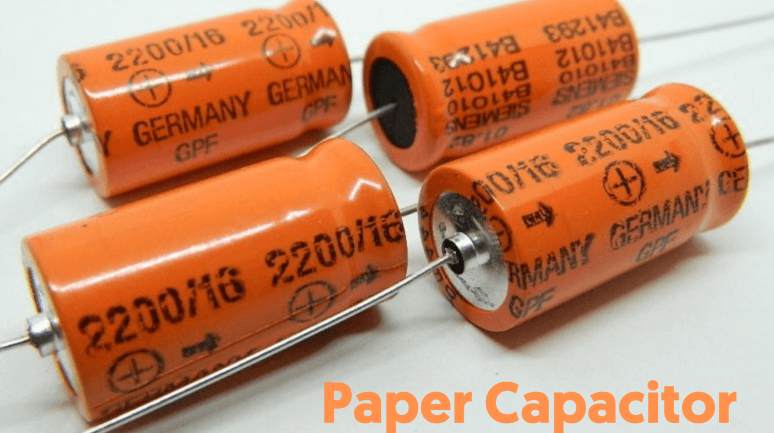
Figure 8: Paper Capacitors
Characteristics of Paper Capacitors
Paper capacitors, once needed in early electronics, are made by layering tin foil and paper or oil-soaked paper in a precise alternating pattern. This structure is then tightly rolled into a cylinder and encased in durable plastic housing. This design optimizes both insulation and capacitance.
The process begins with alternating layers of tin foil and paper or oil-soaked paper. This combination enhances the capacitor’s insulation and capacitance properties. The layered materials are then rolled tightly into a cylindrical form. This step ensures a compact and efficient structure. The rolled cylinder is encased in a robust plastic housing. This protective casing ensures durability and stability. Though their usage has decreased with the advent of advanced materials, paper capacitors were dynamic during the early stages of electronic development. Their simple manufacturing process and effective capacitance made them requisite.
Today, paper capacitors are less common but still used in specific scenarios. They are valued for their ability to operate at high voltages and their strong dielectric strength. These unique properties make them suitable for certain specialized applications.
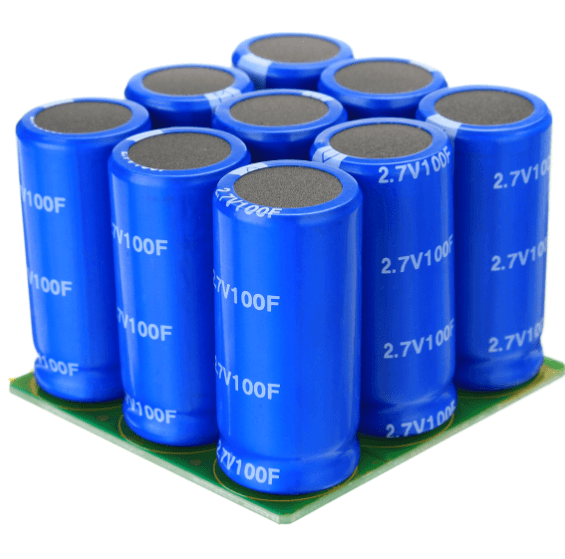
Figure 9: Supercapacitors
Functions of Supercapacitors
Supercapacitors, also known as ultracapacitors, are exceptional at storing large amounts of electrical charge, merging the rapid charge and discharge capabilities of traditional capacitors with the significant energy storage capacity of batteries. Their charge storage mechanisms include double-layer capacitance, where charge is stored at the interface between the electrode and the electrolyte, and pseudo capacitance, facilitated by faradaic electron transfers through electrochemical reactions.
These mechanisms enable supercapacitors to achieve capacitance values significantly higher than those of standard capacitors, making them obligatory for applications that require quick energy delivery. They play a serious role in regenerative braking systems of vehicles, where they capture and reuse kinetic energy almost instantly during braking, and in power stabilization within energy grids, providing immediate responses to load changes. Supercapacitors' versatility and efficiency make them dynamic for modern energy management and storage solutions, driving advances in automotive and industrial applications and positioning them as required components in contemporary technology.
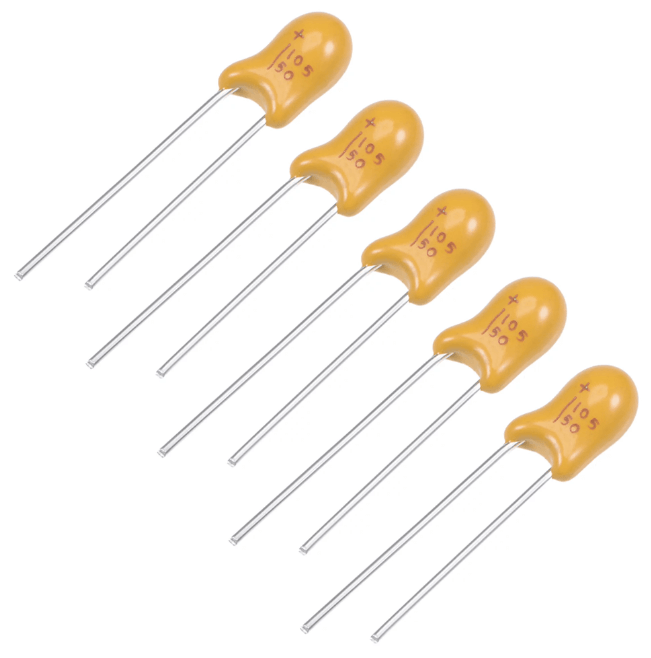
Figure 10: Tantalum Capacitors
The Role of Tantalum Capacitors
Tantalum capacitors are highly valued for their impressive capacitance density and superior frequency response, leveraging tantalum metal for the anode, which is coated with a thin oxide layer that functions as the dielectric. This formation allows for the creation of extremely thin yet effective dielectrics, producing capacitors that are stable and compact. The anode's tantalum composition provides a robust base, while the thin oxide layer acts as a dielectric, enabling high capacitance in a compact size.
Nevertheless, despite their numerous advantages, tantalum capacitors must be handled with care due to the risk of thermal runaway, where an increase in temperature can lead to failure. To counter this risk, they are often equipped with safety features like fuses or thermal cutoffs, which help prevent overheating and ensure safe operation. Their robust performance and compact size make tantalum capacitors a popular choice in various sectors of the electronics industry, particularly in portable devices and automotive electronics.
Diverse Applications of Capacitors
Capacitors are desired components in numerous electrical and electronic applications due to their ability to quickly store and release energy.
Power Supply Units: In power supply units, capacitors filter and smooth out voltage fluctuations, ensuring a stable power output.
Energy Storage Systems: Capacitors are integral to energy storage systems. They accumulate and dispense energy rapidly, aiding in power management and enhancing efficiency.
Provides Power for the Startup Circuit: In motor start circuits, capacitors provide the initial surge of energy required to start electric motors. This surge is desired for overcoming the initial inertia and getting the motor running.
Ensure Signal Transmission: Capacitors play a serious role in signal processing. They filter and modify signal integrity, ensuring clear and accurate transmission and reception of data across communication devices.
Broad Utility: Their rapid charge and discharge capabilities make capacitors requisite in various devices, from consumer electronics to large-scale industrial systems. This broad utility and versatility highlight their importance in modern electronic design and implementation.
Conclusion
The exploration of capacitors reveals a technological landscape where precision, innovation, and functionality merge to produce the components necessary for modern electronics to function. From fixed and variable types to advanced supercapacitors, each class of capacitors serves distinct purposes across various sectors, including consumer electronics, automotive, and aerospace industries. Advanced manufacturing processes, such as etching, anodization, and sintering, are risky in tailoring capacitors to meet specific performance criteria, thereby ensuring their efficacy and durability in challenging environments.
As electronic devices continue to evolve, the demand for capacitors that offer higher capacitance, reliability, and energy efficiency will undoubtedly increase. The detailed study of capacitor types, construction, and applications not only enhances our empathy for these key electronic components but also highlights their influential role in pushing the boundaries of technological advancement. This positions capacitors not just as mere components but as key elements in shaping the future of electronic design and innovation.
Frequently Asked Questions [FAQ]
1. Which is the most common type of capacitor used in power supplies?
The most common type of capacitor used in power supplies is the electrolytic capacitor. These capacitors are favored for their high capacitance values and the ability to handle relatively high voltage levels.
2. What is the simplest and most widely used capacitor?
The ceramic capacitor is known for its simplicity and widespread use. It is small, inexpensive, and commonly found in various electronic devices, from simple home appliances to complex circuit boards, primarily used for general filtering and decoupling applications.
3. How to identify capacitor types?
Capacitors can be identified by their physical characteristics and markings. Electrolytic capacitors are typically cylindrical with polarity markings. Ceramic capacitors are small, disc-like, or rectangular without polarity markings. Film capacitors are often in a boxed shape. The capacitance value, voltage rating, and other specifications are usually printed on the capacitor body.
4. What type of capacitors last the longest?
Film capacitors are known to have the longest lifespan among capacitors. They are robust, stable, and less prone to degradation over time compared to electrolytes, making them suitable for applications requiring longevity and reliability.
5. What is the lifespan of a capacitor?
The lifespan of a capacitor varies depending on its type, quality, and operating conditions. Electrolytic capacitors typically last between 2,000 to 5,000 hours at their rated voltage and temperature, but this can extend significantly under less stressful conditions. Film and ceramic capacitors can last much longer, often functioning reliably for decades under normal conditions.